- Presentation Slides
- Concept & Plan
In the final project, Chanel and I hope to discuss fashion as a communication tool for groups with mental disorders, specifically focusing on bipolar disorder (formerly called manic-depressive illness or manic depression), a mental illness that causes unusual shifts in a person’s mood, energy, activity levels, and concentration.
Fashion has been a way of self-revelation and expression. By exploring sensors and mechanisms, we hope to visualize the wearer’s mental and body changes and help them communicate with people around them in a better and more unique way. Especially for Bipolars, they may find themselves yearning for intensive interactions and communications for some time, while later retreating to themselves and only wishing for a stable companionship.
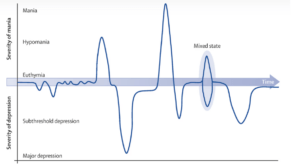
[Periodic curves of the emotion of bipolar, by Iria Grande, Michael Berk, Boris Birmaher, Dr Eduard Vieta]
The project was inspired by Chanel’s personal experience with her bipolar friend. Based on her observation, she found that bipolar may find themselves trapped in a dilemma where they have a hard time balancing their mood and building stable friendships. Also, according to our background research about existing fashion relevant to the topic, We found that seldom of they address interactions with the outside world and the display of mood cycles of individuals with bipolar disorder. However, we believe that these aspects are crucial for understanding this disorder.
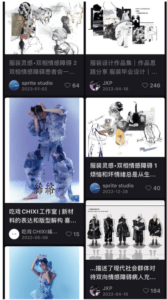
[A screenshot from Little Red Book when searching “bipolar disorder fashion”]
Thus, our project hopes to visualize the mood cycle of bipolar and display their social lives in an interactive way.
Later in the presentation and discussion with friends, we were inspired that the project could be more focused on how to help bipolar and other groups with mental disorders socialize. In other words, not just by demonstrating, but through the exploration of mechanisms and new materials, we could help the future design of clothes for people with mental disorders.
- Our Sketch
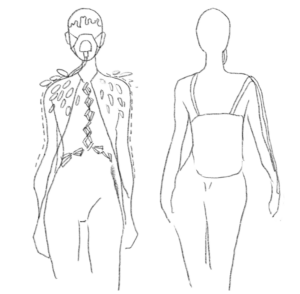
- Mechanism &Prototyping
- The Breathing Machine
The breathing machine will be working together with the distance and pressure sensors to showcase different periods of bipolar experience.
The following is our initial plan for sensors.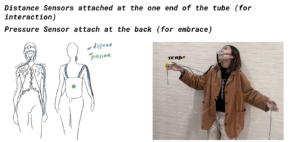
During the class, Marcela suggested we reconsider the position of distance sensors to make the interaction more natural. We will reconsider this aspect in our following working process.
The breathing machine itself mainly includes the following elements: masks, tubes, and pneumatic inflatables.
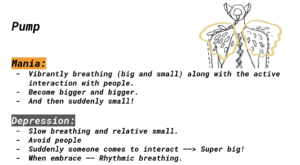
For the pneumatic inflatables, we had the following attempts:
Silicone ➡️ Rubber fingertips ➡️ Silicone 2nd trial ➡️ “Rubber fingertips Pro”.
Before Class:
We made a silicone mold together under the guidance of Marcela in her remaker space. The process was divided into two parts, preparing the silicone (mixing A & B) and pouring the silicone into the laser-cut mold.
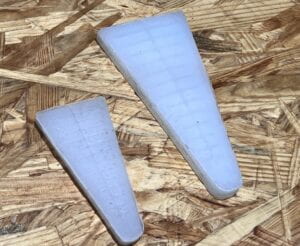
Later, we tried out using the fingertips from the rubber gloves that we bought for previous assignments, and they worked very well in terms of imitating breaths, plus they were much easier to prepare and lighter to wear.
After Class:
We didn’t want to give up on silicone that quickly because we thought the material could create a better and more exaggerated visual effect. The next day after the presentation, we had a second trial. Inspired by a project that made a breathing skin, we decided to laser cut a mold by ourselves and experiment with something similar. Chanel modeled and printed a few parts as the air layer, and I laser cut a square box as a silicone container. It turned out that, though the second layer was very thin, it was still very hard to get the 3D-modeled part out of it after it was done.
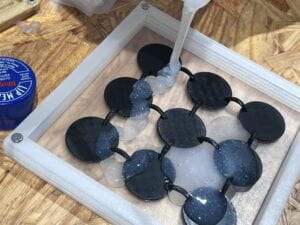
We then switched to using baking paper as the air layer. Since the connecting parts were narrow and some were accidentally stuck together, it was a bit hard for the air to go through, and the visual effect at the end was not great.

After two failed attempts, we went back to rubber fingertips. We tried to add more of them to test how many could two motors supply, and add variables like different textures and colors of rubber gloves. We also tried with the different hose connectors to see which worked better.
We tried to build more with 3-hole hose connectors right after our failed attempts with silicone. It worked well.
Later during the spring break, we bought the Y-shape hose connectors and 4-hole hose connectors. And we built a super big and long one with them. However, the effect is not that good. We then divided them into several parts. Then they worked better.
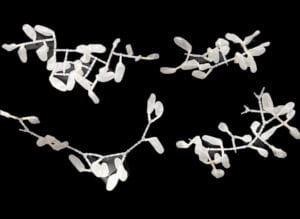
Thus, we realized that we may need more power and pumps to achieve the effects we want to achieve. Also, instead of building a very big one, we are thinking about building smaller ones and placing them on different parts of our bodies.
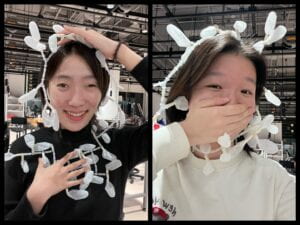
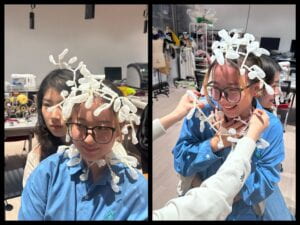
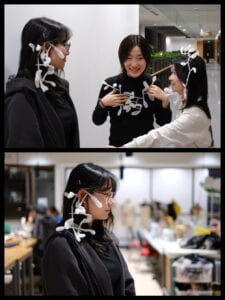
Thus, we may want some not-that-heavy-&-big pumps to support our work. We need to consult professors for help.
-
- The Scissor Mechanism
This part was inspired by our first pair work, a breath-taking embrace, a wearable prototype that whenever you raise your arms for handshaking/hugging, the rubber band is tightened and the screws can cause pain. Using a scissor mechanism that we laser-cut and composed on our own, we adopted the same principle. When bipolar is reaching out, they feel happiness (later there will be a sensor attached at the end of the wearer’s finger and a tube connecting the sensor and mask, indicating that the oxygen comes from social life) and pain (bipolar know at the same time that they may alienate their friends during the depression. The scissor mechanism is tightened when raising arms, and it is choking the wearer, shown in the video) at the same time.
-
- Light & Sound
As for the light, we plan to use different lighting patterns with neopixels to indicate different stages of bipolar.
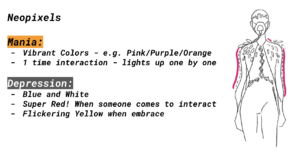
Also, during spring break, I gained another inspiration when visiting an aquarium in Japan (shown in the video below). After talking to Chanel and consulting our friends from Kinetic Light, we are thinking about using an LED matrix inside our clothes to achieve similar effects.
As for the sound, in Project 1, we had some good experiments with sound (sensors & Arduino & Processing) and we decided to further develop sound art in clothes in the final project.
-
- Decoration
The wires in the rotation mechanism illustrate the periodic curves of emotion of bipolar very well, and we may use it as a head decoration.
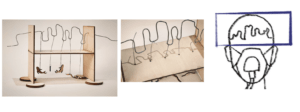
-
- More details can be seen in our slides!
- Reflections & Next Steps
- Based on the suggestions from Marcela and our peers, we realized that there are several parts we need to reconsider in our project:
-
- We need more subjective knowledge about bipolar disorder and try to create more nuanced and caring storytelling. Many peers mentioned that individuals with bipolar disorder may not want this topic to be discussed or placed under the spotlight. After consulting with Chanel’s friend who has bipolar disorder after class, he mentioned that this topic indeed needs discussion, and we discussed our project with him. Based on his insights and suggestions from classmates, Chanel and I decided to conduct more research on bipolar disorder and interview individuals with bipolar disorder to understand how they truly wish this project to be presented. Additionally, we realized that some wording in our presentation may come across as offensive, so we decided to rephrase them to make them more respectful.
- Rethink a more sensible way of interaction. Originally, in our presentation, we wanted to demonstrate through different actions the varying interaction needs of people with bipolar disorder at different stages. However, the high-five gesture we initially planned for the manic phase didn’t resonate with everyone. Therefore, we need to improve this by interviewing a group of people with bipolar disorder.
- Experiment more with the pneumatic mechanism. We’ve made several attempts with the pneumatic mechanism, but the effects weren’t as ideal when we added more fingertips. We need more thought and experimentation regarding the arrangement of fingertips and various shapes of plug-in tubes, as well as the combination with heavy pumps.
- Add sensors. We need to experiment with distance sensors and pressure sensors to understand how they function.
- Adjust the layout and consider textiles. Marcela suggested in class that we could even place the fingertips on the face. We found this idea intriguing but need more time to consider how to execute it specifically.
- References
Grande, Iria, et al. “Bipolar Disorder.” The Lancet, vol. 387, no. 10027, Elsevier BV, Apr. 2016, pp. 1561–72. Crossref, https://doi.org/10.1016/s0140-6736(15)00241-x.
Little Red Book. “Bipolar Disorder Fashion.” Screenshot from Little Red Book.
Kang, K. W. personal communication, 2024.
Countless references from Marcela!
Leave a Reply